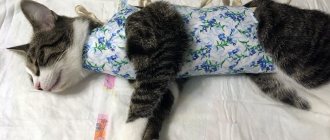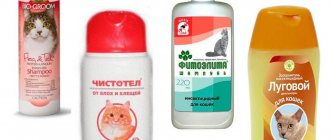Postoperative blanket: what is it and what is it for?
A blanket is a tight “cover” placed over the stomach of an operated cat.
It serves several purposes at once:
- Protects the postoperative wound from contamination by pathogenic and conditionally pathogenic microflora.
- The blanket prevents the animal from trying to scratch and lick its belly. This is a reflexive behavior of a cat trying to speed up the healing process. But in practice, constant licking of the wound leads to the exact opposite result.
- Also, a pressure bandage pulls the edges of the wound together, which promotes healing by primary intention. Simply put, regeneration in this place will go faster, and not so many reserves of the animal’s body will be spent on it.
- A properly applied and high-quality blanket does not allow the muscular wall of the abdominal wall to stretch too much and weaken. This prevents the belly from sagging in the future.
What is a blanket and why is it needed?
A cat blanket is a special postoperative bandage that is required for use after surgical incisions made in the abdominal cavity. The blanket is designed to protect seams from moisture, dirt and microorganisms, prevent infection, inflammation and purulent abscess of the wound. It prevents the cat from licking itself, since saliva and mechanical stress can harm the health of the animal. The blanket protects the postoperative wound from scratching, facilitating faster rehabilitation of the pet.
© shutterstock
After cat sterilization surgery, the veterinarian usually recommends the use of a blanket and gives recommendations on how long and how to wear it. Some types of sutures, such as subcutaneous sutures, require air access, so wearing a blanket in this case is not permissible.
The skill of putting a blanket on a cat is acquired through experience, when the owner tries to tie it several times in a row. The veterinarian should recommend a blanket for the cat after surgery; if you tie it without indication, you can harm the animal. After all, inflammation of the sutures is the most common and unpleasant complication after operations performed on animals.
Blanket for cats from improvised means
It is quite possible to make a blanket with your own hands. This often does not require special cutting and sewing skills. The thing is that it is quite possible to make a bandage from scrap materials. Below we will look at the main options suitable for owners who are not at ease with tailoring skills.
Advice! Regardless of the type of homemade blanket, there is one proven, reliable remedy that prevents the bandage from becoming contaminated with ichor and other wound secretions. We are talking about ordinary... sanitary pads (without flavoring additives). They can easily be slipped under a blanket. In addition, the gaskets are just as easily and quickly replaced with new ones.
Please note that hygiene products should be changed every day. In addition, it is recommended to carry out air baths daily, freeing the cat's stomach from the blanket. This approach promotes rapid healing of the postoperative wound.
Pantyhose blanket
A tights bandage is the simplest option that does not require any special resources. Please note that you should not use “stale” tights: after all, the postoperative area requires complete sterility.
It is also worth looking for a product with increased density: such a “cover” will fit the cat’s body more tightly. In addition, a blanket made of thick tights will simply last longer.
It’s very simple to make: cut a piece of tights 20 centimeters long and pull it over the cat’s belly. In general, that's all. The technique has its pros and cons.
pros
- Any breeder can handle making such a blanket; you don’t need to sew anything.
- Many people have tights; there will be no need to spend extra money.
- There is no need to adjust anything to fit, no ties or other “fasteners” are needed.
- Tights are quite elastic and soft, and therefore many cats quickly get used to them, and therefore do not try to take off unusual clothes every few minutes.
Minuses
- Tights cannot be properly secured to a cat’s body; they will inevitably slide down and curl up.
- If the animal has at least some claws (and they probably do), it only needs to scratch itself a couple of times for your entire structure to immediately be torn to shreds.
- When your pet is young and compact in size, tights may not fit tightly around her belly. This problem can be partly solved by selecting a product with a higher density.
- In addition, nylon gets dirty quickly, so the owner will have to either regularly wash the blankets or constantly cut new tights. There is not much convenience in this.
Sock blankets without ties
The principle of sock blankets is exactly the same as in the case of tights. You need to find a sock of a suitable size (given the abundance of sizes, this is quite simple), and then cut off a piece of its front part so that the cat’s body can be inserted into the resulting “pipe”.
pros
- There are plenty of socks on sale in all sizes and all qualities. You can choose suitable “clothes” for both adult cats and six-month-old pets that are not large in body size.
- Considering the low cost of the original “raw materials,” you can buy new socks every day, and therefore there is no special need to wash them.
- The fabric of the socks is quite dense, but at the same time quite elastic. Such a blanket will stay on the cat’s body much better and is less prone to folding.
- A bandage without ties is more convenient; you don’t have to constantly struggle with tightly tightened knots.
- The socks have quite acceptable strength, and therefore the cat is unlikely to be able to tear them quickly.
Minuses
- Still, a sock without ties and Velcro is not the best solution when you need to swaddle a fairly active pet. The cat will probably be able to pull off the blanket, and therefore you will have to carefully monitor it, not giving it a chance to lick and comb the area of the post-operative wound.
- Avoid cheap socks, as they are often made from low-quality fabrics and may fade. Getting dyes into the wound channel left after surgery is unlikely to lead to anything good.
Blanket from old children's clothes
If you still have old blouses or vests, you can use them to create blankets. You just need to choose clothes that fit tightly enough on the cat’s body without interfering with the animal’s physical activity.
By the way, a blanket can even be made from the sleeve of a child’s or adult’s shirt. The principle in this case is the same as with a bandage made of tights and socks.
pros
- If you can find the right clothes, you won’t have to buy anything either.
- Children's clothes for the little ones already have buttons or ties, which will save the owner from the need to make and adjust them independently. It is especially good when the chosen blouse has ties, since you can ideally select the tightening of the blanket, focusing on the size and physique of a particular animal.
Minuses
- Not everyone has children, and not every cat breeder will have stocks of old children's clothing. But buying something like that for a cat is stupid.
- Dressing a cat in children's clothes can be difficult, and the animal often becomes nervous because it is uncomfortable.
- It is unlikely that the owner of a pet operated on at six months of age will be able to find anything suitable.
Advice. If your pet is not particularly impressive in size, you can look for suitable... doll clothes. Of course, it must be of high quality, made from cotton fabrics.
Towel blankets
Perhaps one of the most common and popular options, showing decent efficiency. Note that for making blankets it is best to use simple cotton towels (you can use “waffle” towels, but soft ones).
The method of use is simple: you need to cut holes in a piece of fabric for the cat’s paws, and then bring the edges of the towel together on the animal’s back. To achieve reliable fastening of the blanket, you will need to sew on the ties.
pros
- There is definitely a towel in everyone’s home.
- Attaching ties to the edges of towels doesn't require any special sewing talent, as it only requires a couple of stitches.
Minuses
- The fabric of towels does not always have sufficient elasticity, and therefore the bandage gradually “looses”.
- Usually the fabric of towels does not have sufficient density, and therefore it is not always possible to sew ribbons for ties to it well. This leads to the fact that the latter constantly come off. Attempts to replace them lead nowhere, since the fabric is already greatly weakened and torn.
Sewing blankets from improvised materials
Below we will describe how and from what you can make a blanket if you don’t have any suitable material or patterns at hand. You don't need any special cutting and sewing skills.
Scheme of overalls for a cat
Pantyhose blanket
The simplest option, which requires virtually no resources. There is only one rule: you need to use clean tights, since the animal definitely needs sterility after surgery and sterilization. It is recommended to use thick tights that will fit the cat's body well.
Important! The blanket is made like this: a piece of trouser leg 20 cm long is cut off and pulled over the cat’s belly. Additionally, you can make holes for the paws
New Year's suit for the British
Sock blankets without ties
The product is made from socks or stockings in the same way. Find the perfect size sock and cut off the front to create a fabric tube. The cat's body is inserted into it, fixing its stomach.
For your information! The most remarkable thing is that even if you don’t have the appropriate sizes at home, you can always buy clean and new socks at any clothing store for a few tens of rubles.
Cat blanket from a baby bodysuit
Blanket from old children's clothes
Old children's clothing in the form of jumpsuits and vests also works well. You should choose something that fits comfortably on your body and is fixed on it. If you don’t have anything like this at hand, then you can make a blanket from an ordinary sleeve of a children’s jacket that stretches well.
Fashionable outfit with a hood
Towel blankets
The most common option involves making it from a simple cotton towel. A cut of the required length is made, and holes for the paws are cut out, based on the anatomical features of the cat. Holes are cut in it for the neck, paws and sometimes the tail. The final stage involves creating a cylinder by sewing the ends of the towel together or sewing on strings.
If the cat is to be sterilized, then you need to buy a blanket
We sew a blanket for a cat with our own hands
Despite all the advantages of homemade blankets from improvised means, they also have quite significant disadvantages. In particular, it can be difficult to choose an individual size, and not everything is good with the materials.
The only way out (unless, of course, the owner wants to buy a ready-made option) is to sew the blanket yourself. This is not difficult to do, even if you don’t have much sewing experience.
Taking measurements for a pattern
To know what size the blanket should be, you must first take all the necessary measurements (using a measuring tape, of course).
The pattern is drawn based on the following data:
- Chest volume.
- Body length (body only, no need to measure tail).
- In addition, you need to take a measurement of the distance between the paws (between the front and between the hind).
Some breeders also advise measuring the coverage of the limbs themselves, but this, in our opinion, is unnecessary. The fact is that this information is needed to accurately calculate the length of the ribbons, but it can be determined by eye.
Below we give an approximate view of the pattern. Using the measurements of your pet, you need to transfer it to measuring paper. The diagram below clearly shows where exactly the ribbons that serve to secure the blanket to the animal’s body need to be sewn. If the owner is comfortable with a needle and thread, he can make a blanket with Velcro. They are much more convenient.
Advice. When copying a pattern, do not forget that you should add about a centimeter to all measurements. This is necessary in cases where the edges will be stitched during sewing. If Velcro is used instead of ties, you need to increase the width of the blanket by about three or five centimeters.
There is no special need for “cross stitching”. If the cat owner does not know how to sew at all, no one forbids simply transferring the contours of the pattern onto the fabric and then cutting out the finished product. Of course, the strength and convenience of such a blanket will be lower, but the finished product will perform its functions in full.
Choosing fabric for blankets
The material for the bandage must meet the following requirements:
- You need to choose a fabric that is soft and elastic enough, but at the same time not prone to strong stretching.
- Under no circumstances should the material crumble, contaminating the postoperative wound with fibers and other debris. To test this characteristic, you need to take a small piece of material and tie it tightly. Good fabric will not tear and pieces of thread will not fly off.
- In addition, we strongly advise against choosing dyed fabrics, since, despite all the assurances of the manufacturers, they can fade.
Velcro or ribbons: which is better?
A separate section should describe the process of choosing between Velcro and regular ribbons. Each owner is free to decide for himself which option is more suitable for his pet, since there is no consensus on this.
We will simply describe the positive and negative aspects of each type of fastener.
Pros of ribbons
- They can be made from the same fabric, no need to buy anything extra.
- Easier to sew.
- The ties are unlikely to unravel spontaneously.
Cons of ribbons
- The cat can cling to surrounding objects with them.
- If the knot is too tight, it may be difficult to untie the ribbon.
Pros of Velcro
- They are very comfortable. “Sticky” fasteners greatly simplify the process of putting on and taking off the blanket.
- Such fasteners are very compact, the cat is guaranteed not to get caught on anything.
Disadvantages of Velcro
- Additional financial expenses will be required.
- Velcro quickly becomes dirty and loses its quality.
- The cat can quickly learn how to unfasten them.
How to properly put on and tie a blanket on a cat
The postoperative bandage is worn correctly if it fits snugly to the pet’s body and does not dangle or sag.
Instructions:
• The pet should be laid on its side (right or left - as convenient for the owner). • The edges of the blanket are brought together and tied with ties, starting with the head ones. • And now – attention. The second garter is tied diagonally (crosswise) to the corresponding ends of the third. This is necessary for better fastening. • Belly ties are tied as usual. • The last and penultimate (not counting the area for the tail) fastenings are also tied diagonally.
The ties do not need to be pulled tight. The bandage should be worn so that it does not dangle or sag, but you can stick your little finger between it and the body. If you tighten the nodes, you can disrupt the local blood supply. Make sure that the edges of the ties are not too long.
How to properly put a blanket on a cat
It is better to tie a blanket while the animal is still under anesthesia. Adjust the length of the ties so that the loose ends do not interfere with the animal.
It is better to immediately cut off the excess so that the cat cannot accidentally get caught on something and injure itself during the owner’s absence. Observe how the cat behaves. If wearing a blanket for the first time causes stress, remove the product from it and try putting it on again after a while. Don't expect a pet in a bandage to behave the same way as usual, because these freedom-loving animals do not like to have something put on them.
Making a DIY bandage for cats is not that difficult. But you need to follow all the rules of work and wear it correctly.
The subsequent effectiveness for your cat depends on the cut of the blanket. It also needs to be tied correctly. If the ties are too tight, then the stitches and wounds after sterilization in cats will take a long time and heal poorly. And if they are too loose, the seams will rub when moving, or the cat will try to take it off.
You need to put a blanket on a cat like this:
- lay out the product and straighten the ties on it;
- carefully place the cat on top and secure the ties in front in the area of the head and forelimbs;
- We tie the back ties in pairs and tie them in the cat’s pelvic area.
The sequence of actions may differ slightly from the one given, it all depends on the cut of the bandage. Be sure to ensure that the blanket is properly secured. Let the cat walk around the room, if it is calm and does not try to remove it, then everything has been done correctly.
Most often, animals do not really like such clothing. They constantly chew and tear the bandage, trying to get rid of it. That is why you need to carefully select the fabric if you sew it yourself, so that it is durable and pleasant to the touch.
In order for the blanket to perform its function, it must be worn correctly. When putting on a bandage, it is forbidden to tighten it too much with ties. It is also prohibited to let it dangle from the pet. The product should not hinder the movement of the animal. The blanket is worn with a tight fit to the body.
A homemade bandage, if made correctly, will allow your pet to endure the postoperative recovery period well and return to a full life.
If the animal is under anesthesia, then putting a bandage on it will be quite simple. Another situation is when the cat resists. Then doing it alone is not recommended. It's better to ask someone at home to help.
Caution: Do not squeeze the cat too hard, as this may cause the seam to come apart. If you need to put a blanket on a cat that has already recovered from anesthesia, act not with coercion, but with affection
Those who are going to put a bandage on a pet for the first time and feel unsure should practice on inanimate objects, for example, toys, and only then approach the cat.
Sometimes the cat strongly resists and does not allow the blanket to be put on itself. After some time, you can repeat the attempts, because over time the animal gets used to this procedure. As well as, for example, rubbing the eyes.
Step-by-step instruction:
- First you need to tie the laces closest to your neck. Grab your head, but gently.
- Now tie the ones between the neck and front legs.
- Tie each pair of laces towards the tail.
- The last two ribbons must be tied crosswise around the cat's rump.
And do not forget to leave the anus and urethra open. Otherwise, the pet will not be able to go to the toilet normally and will worry or stain the bandage. Make sure that the blanket not only does not cover, but is not too close to the urethra and does not become wet from the animal’s urine.
Sometimes it happens that a cat, after putting a bandage on it, cannot move calmly. Then it is worth loosening the tapes so that the animal does not suffer, because he already needs to recover from the operation.
You should put on the blanket as carefully as possible: after the operation, when the stitches are healing, any careless movement can cause pain to your pet. Tying a post-operative blanket is an art
But after studying the diagram below, you can easily figure out what’s what.
Blanket fastening diagram
We tie the sixth and seventh pair on the outside of the thighs. Already tied, we connect the ends of ties 6 and 7 above the base of the tail.
What to do if your cat takes off his blanket
Regardless of the type of blanket used, owners of operated animals often face the same misfortune: their pet takes off the blanket. It is unlikely that it will be possible to constantly monitor the animal, and it will be very tiring for the owner. Therefore, it is better to go the other way.
Physical limitation of mobility
An option ideal for night time. The cat must be placed in a portable cage, basket or box that limits the pet's mobility. Having lost the ability to constantly spin and run, she is unlikely to be able to remove the blanket.
Surgical collar
This collar, also called the “Elizabethan” collar, resembles a funnel worn around a cat’s neck. This design reliably prevents all “rash” actions of the animal, preventing the removal of the bandage.
However, this method is not very suitable for young cats, as they can be very nimble.











